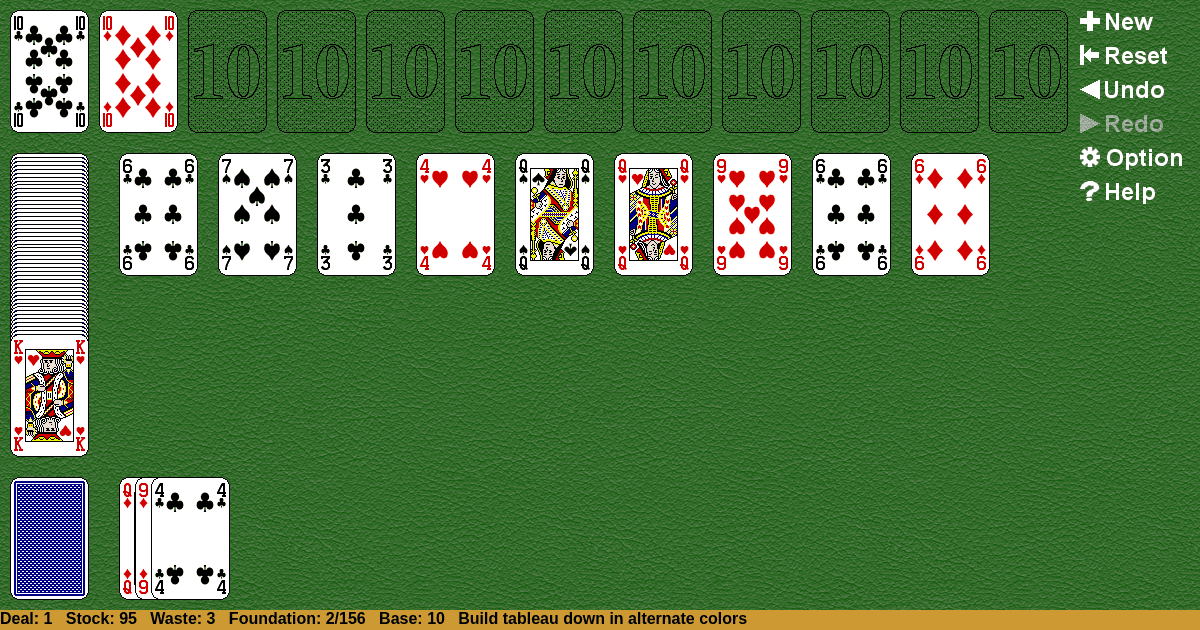Three Demons
Home |
How to play |
FAQ |
About
How to play Three Demons?
Game Objective:
The primary goal in Three Demons Solitaire is to build up four foundation piles in ascending order by suit, starting from a variable base card, until all 52 cards are transferred from the tableau, reserve (the "demons"), and stock to the foundations.
Setup & Layout:
- Use a standard 52-card deck with no jokers.
- Reserve ("Three Demons"): Deal 13 cards face down in a single stack; turn the top card face up. This stack is called the "demon" or reserve.
- Foundations: Deal the next card face up to start the first foundation pile. The remaining three foundation piles will be started with cards of the same rank as this base card, as they become available.
- Tableau: Deal four cards face up in a row below the foundations. These form the tableau piles.
- Stock: Place the remaining cards face down as the stock pile.
- Waste: The waste pile is formed during play as cards are drawn from the stock.
Key Play Areas:
- Foundations: Four piles, built up by suit from the base card, wrapping from King to Ace if necessary.
- Tableau: Four piles, built down in alternating colors, wrapping from Ace to King if needed.
- Reserve ("Three Demons"): Stack of 13 cards, only the top card is accessible.
- Stock: Draw pile for dealing cards during play.
- Waste: Discard pile for cards drawn from the stock.
Three Demons Solitaire Rules:
- Foundations: Build up by suit, starting from the base card (the first card dealt to the first foundation), wrapping from King to Ace if necessary. Each foundation must start with a card of the same rank as the base card.
- Tableau: Build down in alternating colors (red on black or black on red), wrapping from Ace to King if needed. Full or partial sequences in correct order and color may be moved as a unit between tableau piles.
- Reserve ("Three Demons"): Only the top card is available for play. It can be moved to the tableau or foundations if legal.
- Stock & Waste: Cards are dealt from the stock to the waste pile in groups of three. The top card of the waste is available for play to the tableau or foundations.
- Empty Tableau Spaces: Must be filled immediately with the top card from the reserve. If the reserve is empty, fill with the top card from the waste pile.
Gameplay:
- Examine all available moves among the tableau, reserve, waste, and foundations.
- Move cards to the foundations whenever possible, following the suit and sequence rules.
- Build tableau piles down in alternating colors, moving single cards or valid sequences as allowed.
- When no further moves are possible, deal three cards from the stock to the waste pile. Only the top card of the waste is playable.
- Repeat dealing from the stock as needed; unlimited passes through the stock are allowed.
- When a tableau space is vacated, fill it immediately with the top card from the reserve. If the reserve is empty, use the top card from the waste pile.
- Continue play until all cards are moved to the foundations or no further legal moves are possible.
Winning & Losing Conditions:
- Win: The game is won when all 52 cards are built onto the foundations, each in ascending order by suit, starting from the base card and wrapping as necessary.
- Lose/Unwinnable: The game is lost if no more legal moves can be made and not all cards have been built onto the foundations.
Special Rules & Edge Cases:
- Filling Empty Tableau Spaces: Always fill empty tableau spaces immediately with the top card from the reserve. If the reserve is exhausted, fill with the top card from the waste pile.
- Wrapping Sequences: Both foundation and tableau sequences can "wrap" (e.g., King can be followed by Ace, and Ace by King) when building up (foundations) or down (tableau).
- Stock Re-deals: Unlimited passes through the stock are permitted; after dealing through the stock, pick up the waste pile, turn it over, and use it as the new stock.
- Moving Sequences: Entire valid sequences in the tableau can be moved as a unit to another tableau pile, provided the move follows the descending, alternating color rule.
- Reserve Depletion: Once the reserve is empty, tableau gaps can be filled with the top card from the waste pile.
Note: The name "Three Demons" refers to the reserve stack, which is central to the game's challenge and strategy.
This guide synthesizes the rules from authoritative sources on Demon/Canfield Solitaire, which is the ruleset used for "Three Demons Solitaire".

Solitaire Collection
About Three Demons
Rate (Three Demons)
4.7 / 5
1,916 votes



























































